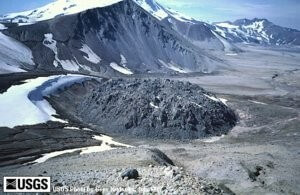On June 6, 1912, Mount Novarupta, in central Alaska, exploded into a fiery volcano. The eruption was preceded by a series of severe earth rumblings. Over the many weeks of continued erupting over 700 feet of ash was deposited in the vicinity of the dome. Trees were smashed, all vegetation was killed and the air became thick with acidic fumes.

The ash was so thick that at nearby Kodiak, for two days following the eruption, local residents could not see a lantern held at arm’s length.
When Novarupta exploded, nearby Mount Katmai collapsed. The result of the eruption was 14 earthquakes of magnitude 6 to 7 rocked the region, and countless smaller shocks occurred.

What, you may ask does this US volcano have to do with Canada?
Within days of the eruption, a cloud of acidic gas spewed from the mountain. Several residents in Vancouver reported that the acid was destroying clothes that were hung out to dry. Mainly White Sheets would fall apart when they were brought back inside to iron. The volcano’s acidic cloud was dissolving the laundry away!
The effects of the volcano were felt well beyond the falling ash. They were felt all over the world. The fine ash made it’s way into the upper atmosphere and formed a haze. This reduced the amount of sunshine and caused the cold summer of 1912, in northern hemisphere. The image below shows the comparison of the Novarupta Volcano Eruption to other Volcanoes.

Leave a Reply